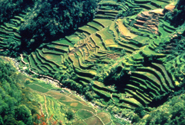Philippines

- © UNESCO
- Rice Terraces of the Philippine Cordilleras
The Philippines joined UNESCO on November 21, 1946.
The “Palihan” Street Children Education Programme is a UNESCO flagship project launched in Metro Manila in 1997.
The Earthsavers Dreams Ensemble from the Philippines were named UNESCO Artists for Peace in 2003.
Among recent activities, UNESCO is supporting the development of an emergency knowledge base in the Philippines. In 2007, a Community e-Disaster Center was set up and a training workshop for health emergency managers held in the Eastern Visayas region.
The book “Living Landscapes and Cultural Landmarks: World Heritage Sites in the Philippines” was launched at UNESCO in June 2007 to celebrate the 35th anniversary of the 1972 UNESCO World Heritage Convention. The album highlights all five sites in the country, known as a “biodiversity hotspot”.
Another item of the Philippines’ documentary heritage – in addition to Paleographs and the Radio Broadcast of the Philippine People Power Revolution – was added to the Memory of the World Register in 2007: the José Maceda Collection, rare recordings of Southeast Asian music, made in 1936.
The Philippines has two biosphere reserves in the World Network of Biosphere Reserves,
Puerto Galera and Palawan.

